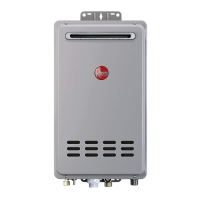5
IMPORTANT SAFETY INFORMATION
WARNINGS:
• The installation of gas piping must conform to local
utility company requirements and/or in the absence of
local codes, use the latest edition of National Fuel Gas
Code (NFGC), ANSI Z223.1/NFPA 54, or CAN/CSA B149.1,
Natural Gas and Propane Installation Code.
• Install a gas pressure regulator in the gas supply line.
The regulator should not exceed the maximum supply
pressure. DO NOT use an industrial-type gas regulator.
• Should overheating occur or the gas supply fail to shut
off, turn off the manual gas control valve to the water
heater.
CAUTIONS:
• D o not attempt repair of electrical wiring, gas piping,
remote control, burners, vent connectors, or other safety
devices. Refer repairs to qualified service personnel.
• Turn off the manual gas shut-off valve if the water heater
has been subjected to overheating, fire, flood, physical
damage, or if the gas supply fails to shut off.
• D o not turn on the water heater unless the water and gas
supplies are completely opened.
Natural Gas and Liqueed Petroleum Safety
DANGERS:
• Never attempt to convert the water heater from natural
gas to L P. The water heater must only use the fuel type
in accordance with listing on data plate—natural gas
for natural gas units and LP for LP units. Any other fuel
usage will result in death or serious personal injury from
fire and/or explosion. This water heater is not certified
for any other fuel type.
• Both natural gas and propane (LP) have an odorant added
to aid in detecting a gas leak. Some people may not
physically be able to smell or recognize this odorant. If
you are unsure or unfamiliar with the smell of natural
gas or L P, ask the gas supplier. Other conditions, such
as “odorant fade,” which causes the odorant to diminish
in intensity, can also hide or camouflage a gas leak.
• Water heaters using LP gas are different from natural
gas models. A natural gas water heater will not function
safely on LP and vice versa.
• L P must be used with great caution. It is heavier than air
and will collect first in lower areas, making it hard to
detect at nose level.
• Before attempting to light the water heater, make sure
to look and smell for gas leaks. Use a soapy solution
to check all gas fittings and connections. Bubbling at
a connection indicates a leak that must be corrected.
When smelling to detect a gas leak, be sure to also sniff
near the floor.
• Gas detectors are recommended in LP and natural
gas applications and their installation should be
in accordance with the detector manufacturer’s
recommendations and/or local laws, rules, regulations,
or customs.
• Combustible materials, such as clothing, solvents,
cleaning materials, or flammable liquids, must not be
placed in the vicinity of the water heater.
• I f a gas leak is present or suspected:
– Do not attempt to find the cause yourself.
– Never use an open flame to test for gas leaks. The
gas can ignite resulting in death, personal injury, or
property damage.
– Follow the steps listed under “What to Do If You
Smell Gas” found on the front cover of this manual.
Safety

